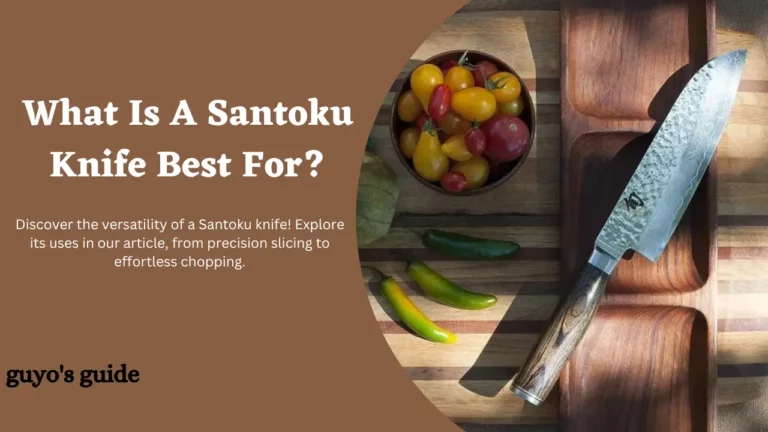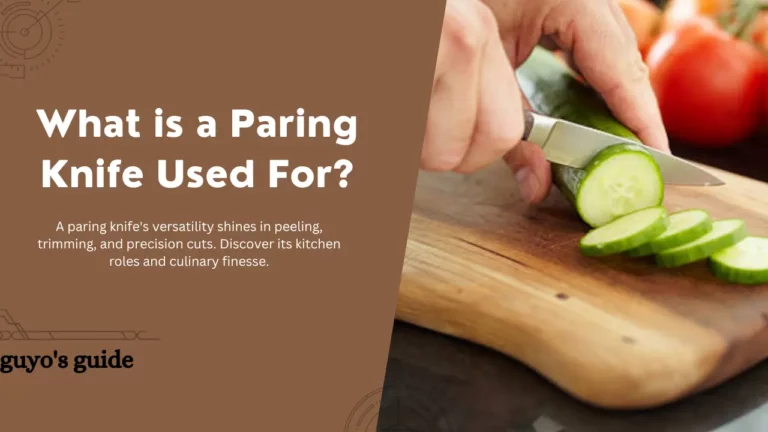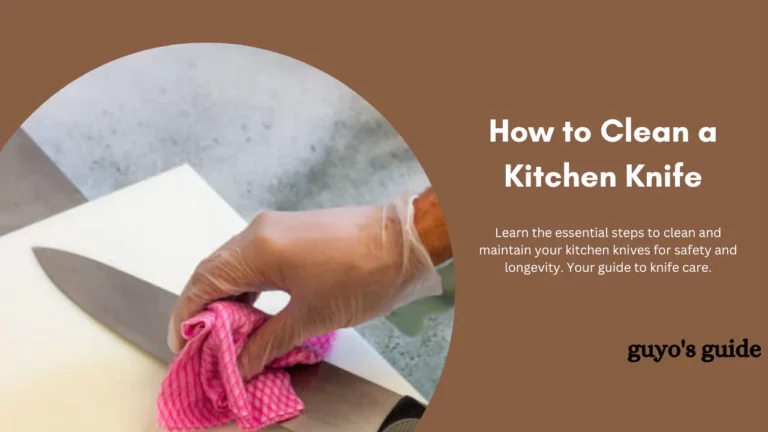Chinese Cleaver vs. Chef Knife (Full Comparison)
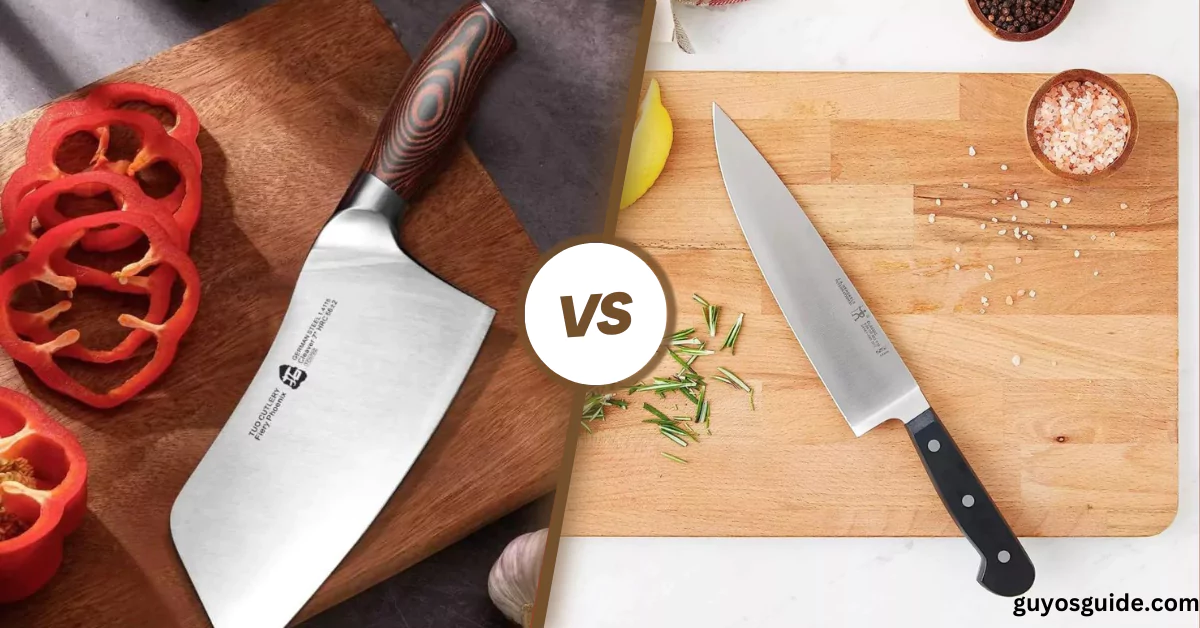
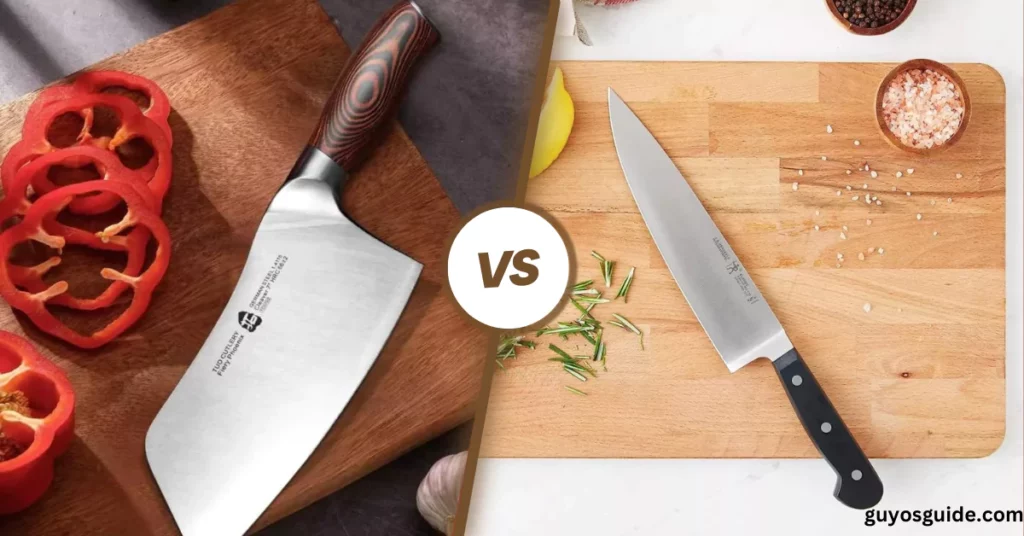
The Chinese cleaver and the chef knife are two essential tools in the kitchen, each with its own unique features and purposes.
While both are used for chopping and slicing, they differ in design and functionality.
In this blog post, we will explore the differences between the Chinese cleaver and the chef knife, helping you understand which one is best suited for your culinary needs.
Let’s dive in.
Chinese Cleaver

The Chinese cleaver, also known as a Chinese chef’s knife or Cai Dao, is a versatile and distinctive knife used in Chinese cuisine and beyond.
It has a broad, rectangular-shaped blade with a sharp edge and a flat profile.
The blade typically varies in length, but it’s notably taller than the typical Western chef’s knife.
Chinese cleavers come in different variations, with some having a more pointed tip and others being more squared off.
Advantages of Using a Chinese Cleaver:
- Versatility: Chinese cleavers are incredibly versatile and can handle a wide range of cutting tasks, making them a staple in Chinese and Asian kitchens.
- Efficient Chopping: The broad blade and flat profile of the Chinese cleaver allow for efficient chopping and scooping, which is particularly useful for preparing vegetables and meat.
- Precise Slicing: Despite their size, Chinese cleavers can be used for precise slicing due to their sharp edge.
- Mincing and Crushing: Chinese cleavers can effectively mince herbs and garlic, and they can even be used for crushing ingredients like ginger.
- Durable: These knives are typically made from robust materials, and their sturdy build can withstand heavy use in the kitchen.
Disadvantages of Using a Chinese Cleaver:
- Size and Weight: The large size and weight of a Chinese cleaver can be intimidating for some users, and it may not be ideal for those who prefer a lighter knife.
- Not Suitable for Precision Tasks: While they can handle a wide range of tasks, Chinese cleavers may not be the best choice for tasks that require high precision, such as filleting fish or intricate vegetable carving.
- Not Ideal for Boning: Chinese cleavers are not designed for deboning tasks, as they lack the flexibility and pointed tips required for such work.
Types of Cuts that Can Be Made with a Chinese Cleaver
Chinese cleavers are well-suited for a variety of cuts, including:
- Chopping: Ideal for chopping vegetables, meat, and boneless cuts.
- Slicing: The sharp edge allows for precise slicing of various ingredients.
- Mincing: Effective for mincing herbs, garlic, and other aromatic ingredients.
- Julienne and Dice: Capable of creating fine julienne and uniform dices.
- Smashing: Used for flattening ingredients like ginger and garlic.
- Scooping: The flat edge is perfect for scooping ingredients from the cutting board.
Chef Knife
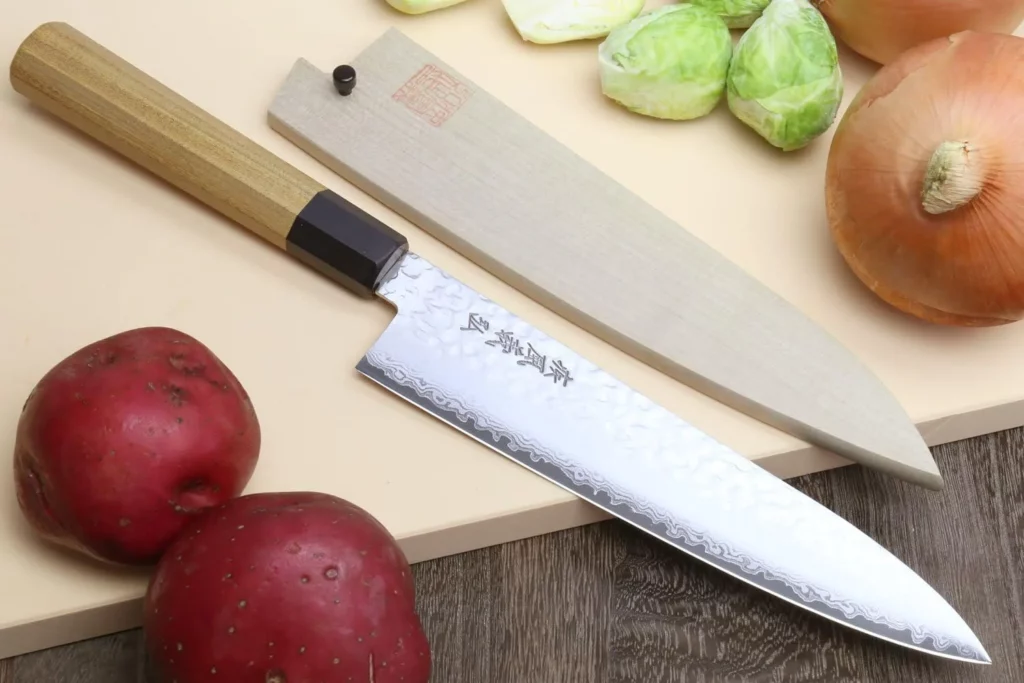
The chef knife, also known as a cook’s knife or French knife, is a multipurpose kitchen knife characterized by its versatile design.
It features a long, broad, and gradually curved blade with a pointed tip. The blade is typically between 8 to 10 inches (20 to 25 cm) in length, making it longer than many other types of kitchen knives.
The chef knife is known for its durable, sturdy, and balanced construction, which allows it to handle a wide variety of kitchen tasks.
Advantages of Using a Chef Knife:
- Versatility: Chef knives are incredibly versatile and can handle a broad range of cutting tasks, making them a fundamental tool in the kitchen.
- Efficient Chopping: The wide blade and curved profile of the chef knife allow for efficient chopping, making it ideal for preparing vegetables and other ingredients.
- Precise Slicing: Despite its size, the chef knife can be used for precise slicing of various ingredients, including meats and fruits.
- Dicing and Mincing: The sharp edge and ergonomic design make it easy to dice vegetables and mince herbs and spices.
- General Food Preparation: Chef knives are excellent for general kitchen tasks, such as peeling, trimming, and cutting a wide range of ingredients.
- Durability: They are typically made from high-quality materials and built to withstand heavy use in the kitchen.
Disadvantages of Using a Chef Knife:
- Size and Weight: The size and weight of a chef knife can be challenging for some users, especially those who prefer lighter knives.
- Not Ideal for Precision Tasks: While it is versatile, the chef knife may not be the best choice for tasks that require high precision, such as filleting fish or intricate vegetable carving.
- Limited Flexibility: Chef knives are relatively stiff, which makes them less suitable for tasks like boning meat or filleting fish, where flexibility is essential.
Types of Cuts that Can Be Made with a Chef Knife
Chef knives are capable of making a wide range of cuts, including:
- Chopping: Ideal for chopping vegetables, herbs, and boneless cuts of meat.
- Slicing: The curved blade allows for precise slicing of various ingredients, from meats to fruits and bread.
- Dicing and Mincing: Suitable for dicing vegetables into uniform pieces and mincing herbs and spices finely.
- General Food Preparation: Useful for various general kitchen tasks, such as peeling, trimming, and slicing.
- Carving: While they are not specialized carving knives, chef knives can be used for carving poultry and roasts when necessary.
Differences between Chinese Cleaver and Chef Knife
| Feature | Chinese Cleaver | Chef’s Knife |
|---|---|---|
| Origin | China | Western countries |
| Blade Shape | Rectangular and flat | Wide and pointed |
| Blade Thickness | Thicker and heavier | Thinner and lighter |
| Blade Material | Typically carbon steel | Stainless steel |
| Cutting Technique | Push cut and chopping | Rocking and slicing |
| Use | Versatile, used for a wide range of tasks like slicing, dicing, and chopping | Versatile, but better for precise slicing and dicing |
| Weight | Heavier | Lighter |
| Handle | Generally wooden handle | Various materials (wood, plastic, composite) |
| Blade Length | Varies but typically longer | Varies, shorter than Chinese cleaver |
| Edge Angle | Wide angle | Narrow angle |
| Maintenance | Requires more maintenance, including drying to prevent rust | Easier to maintain due to stainless steel |
| Food Type | Suitable for slicing meat, bone, and vegetables | Suitable for precise slicing of vegetables and boneless meat |
| Versatility | Less versatile for delicate tasks like slicing herbs | Generally Affordable |
| Price Range | Generally affordable | A wide price range can be expensive |
Which one to Choose between a Chinese Cleaver and a Chef Knife?
When choosing between a Chinese cleaver and a chef’s knife, several factors should be considered.
These factors include personal preference, cooking style, and the types of dishes you frequently prepare.
Here’s a breakdown of these considerations and some recommendations for different cooking scenarios:
Factors to Consider:
- Personal Preference: Your comfort and confidence with a particular type of knife are crucial. Some people have a strong preference for the feel and handling of one knife over the other.
- Cooking Style: Consider the techniques and tasks you perform most frequently in your cooking. Do you chop and push cut more, or do you prefer slicing and rocking motions?
- Versatility: If you want a single, all-purpose knife, a chef’s knife is generally more versatile. It can handle a wide range of tasks with finesse.
- Cuisine: The type of cuisine you cook most often can influence your choice. If you frequently prepare Chinese or Asian dishes, a Chinese cleaver might be a better fit due to its traditional use.
Recommendations for Different Types of Cooking:
- Chinese Cuisine: If you predominantly cook Chinese cuisine, a Chinese cleaver is an excellent choice. Its design is well-suited for chopping, slicing, and various techniques commonly used in Chinese cooking.
- Asian Cuisine: Even if you cook a variety of Asian dishes beyond Chinese cuisine, a Chinese cleaver can still be a versatile and valuable tool.
- Western Cuisine: If you mostly cook Western-style dishes and appreciate precise slicing, a chef’s knife is the go-to option. It excels in tasks like slicing, dicing, and mincing.
- Multicultural Cooking: If you prepare a wide range of dishes from different culinary traditions, a chef’s knife is often the most practical choice, as it can handle various cutting techniques.
- Heavy-Duty Tasks: If you frequently work with tough ingredients, like butchering large cuts of meat or chopping through bones, a Chinese cleaver’s weight and design make it more suitable for these tasks.
- Fine Cutting and Mincing: If you need to make fine cuts, mince herbs, or perform intricate knife work, a chef’s knife’s curved blade is better for these tasks.
FAQs
How can I maintain and sharpen these knives at home?
Proper maintenance and sharpening techniques may differ for each knife, so it’s important to understand the specific care requirements for your chosen knife.
Can I use a Chinese cleaver or chef’s knife to cut through bones?
While both knives can handle light bone-cutting tasks, Chinese cleavers are better suited for this purpose due to their thicker and heavier blade.
Are there variations within each type of knife?
Yes, both Chinese cleavers and chef knives come in various styles and sizes to cater to different preferences and cooking needs.
Can I own both a Chinese cleaver and a chef’s knife?
Absolutely, having both knives in your kitchen can be a great idea. You can choose the one that suits the specific task you’re working on.
Wrap Up
In the world of culinary artistry, the choice between a Chinese cleaver and a chef’s knife ultimately boils down to personal taste and cooking style.
Each knife offers its unique strengths, making them indispensable tools in the hands of skilled cooks.
Whether you prefer the versatility of a chef’s knife or the power of a Chinese cleaver, one thing is clear – your kitchen journey is bound to be more exciting and efficient with the right blade by your side.
So, embrace the choice that resonates with your culinary soul, and let the culinary adventures begin!

